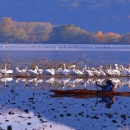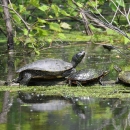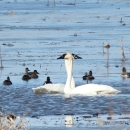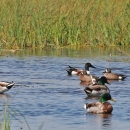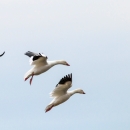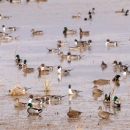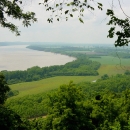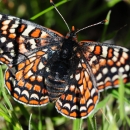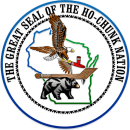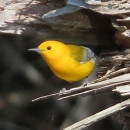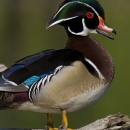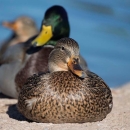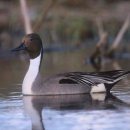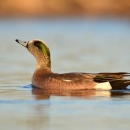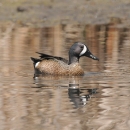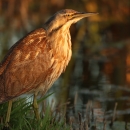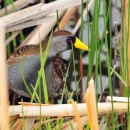States
Illinois, Iowa, Minnesota, Missouri, WisconsinProjects on National Wildlife Refuge System lands
We have selected seven nature-based resiliency projects in the Upper Mississippi and Illinois River basin, an area encompassing lands and waters in five states in the midwest, and includes vast bottomland forests, wetlands and riverine habitats supporting 60% of the countries migrating birds and 40% of North America’s waterfowl, as well as a diverse array of fish and wildlife. As part of the Inflation Reduction Act, $10 million has been allocated to this project area and is the largest climate investment in history—for nature-based resiliency and restoration.
These seven projects will reduce the risks and associated damages of flood and drought by restoring resilient habitats using nature-based solutions like levee removal or setbacks, reconnecting flood plain wetlands and backwaters, reengineered climate-adaptive infrastructure, as well as removing and replacing invasive species invasive species
An invasive species is any plant or animal that has spread or been introduced into a new area where they are, or could, cause harm to the environment, economy, or human, animal, or plant health. Their unwelcome presence can destroy ecosystems and cost millions of dollars.
Learn more about invasive species with native plant species. These projects will benefit fish and wildlife while also providing the ancillary benefits of recreational activities like hunting, fishing and wildlife viewing along with providing neighboring communities environmental services like clean water, air and potential reductions in flood and drought impacts.
Through the Bipartisan Infrastructure Law Bipartisan Infrastructure Law
The Bipartisan Infrastructure Law (BIL) is a once-in-a-generation investment in the nation’s infrastructure and economic competitiveness. We were directly appropriated $455 million over five years in BIL funds for programs related to the President’s America the Beautiful initiative.
Learn more about Bipartisan Infrastructure Law and the Inflation Reduction Act, the Department of the Interior is implementing a more than $2 billion downpayment to restore our nation’s lands and waters. In March, we announced an investment of more than $120 million from the Inflation Reduction Act to rebuild and restore units of the National Wildlife Refuge System and partnering state wildlife management areas that have been affected by adverse weather events. The investment prioritizes projects that promote coastal resilience and climate adaptation, address invasive species threats, and provide for additional data collection needed to support successful natural resource resilience.
The Upper Mississippi and Illinois River basin nature-based resiliency projects represent a unique opportunity to address restoration needs that are designed to reduce the impacts of climate change climate change
Climate change includes both global warming driven by human-induced emissions of greenhouse gases and the resulting large-scale shifts in weather patterns. Though there have been previous periods of climatic change, since the mid-20th century humans have had an unprecedented impact on Earth's climate system and caused change on a global scale.
Learn more about climate change to an ecosystem which is home to a vast array of fish, wildlife and plants, and the people who live, work and recreate there.
| Project name | State | County | Funding |
| Rush Lake Water Control Structure Adaptive Replacement | IA | Louisa | $55,000 |
| Tarr Marsh Climate Resiliency and Restoration Project | IA | Jackson | $345,915 |
| Building Resilience in America’s Big River Forests | IL, IA, MN, MO, WI | Multiple | $1,110,000 |
| Guttenberg Ponds Connection | IA | Clayton | $500,000 |
| Treatment of Bottomland Hardwood Forest | MO | Wayne, Stoddard | $577,500 |
| Replacement and Improvement of Water Control Structures on Ditches 1 and 2 | MO | Wayne, Stoddard | $1,251,000 |
| Upper Mississippi River Pool 6 Sam Gordy’s Slough Connectivity Restoration Project | WI | Buffalo | $250,000 |
Highlights
Sam Gordy’s Slough Connectivity Restoration Project, Wisconsin, Buffalo County
Beginning in April 2025, Sam Gordy’s Backwater Complex, known generally as Sam Gordy’s Slough, will be undergoing a restoration effort that is aimed at habitat improvement. This project area, which is part of Upper Mississippi River National Wildlife and Fish Refuge, includes restoring connections to the main river channel and improving water quality. Sam Gordy’s Slough is approximately 350 acres on the Wisconsin bank in Buffalo County, Wisconsin, in Pool 6 near the town of Winona on the Minnesota side of the river.
Through these investments, we are working with state partners to complete geographically diverse, large-scale projects that are mutually beneficial for these conservation areas, including projects that benefit underserved communities and Tribal interests. The program supports the Biden-Harris administration’s America the Beautiful Initiative, a decade-long challenge to pursue locally led and voluntary conservation to protect, conserve, connect, and restore our nation’s lands, waters, habitats and wildlife.
Learn more about our work through the Inflation Reduction Act.




